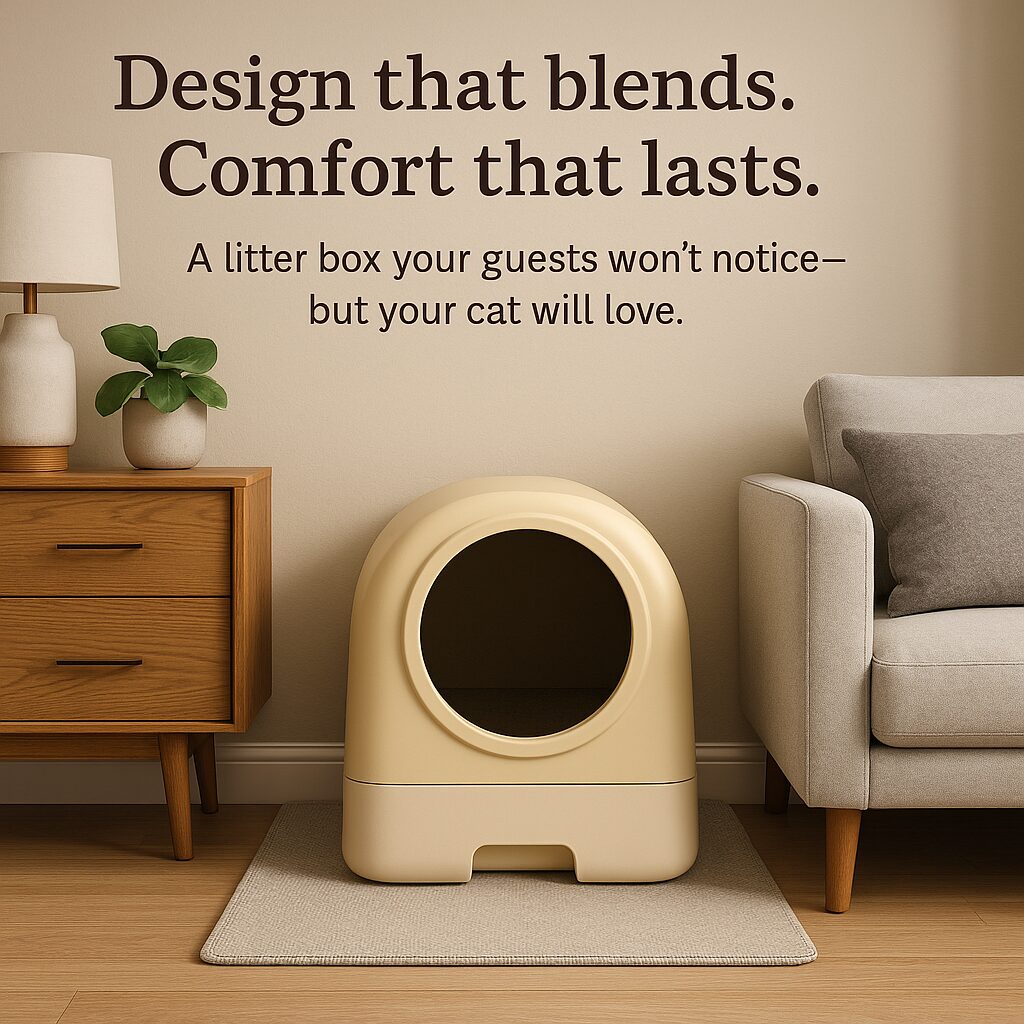Most cat furniture is designed with your cat in mind—but not your home. While it may check the box for function, what you often get are bulky towers, plastic trays, or carpet-covered blocks that stand out in the worst way.
You love your cat. You’ve designed your home with care. You shouldn’t have to choose between the two.
Thankfully, a new generation of cat furniture is reimagining the essentials. From litter boxes that quietly blend into minimalist interiors to wooden cat trees that double as sculptural statements, style and utility no longer need to live on opposite ends of the room.
In this article, we’ll explore two must-have pieces—litter boxes and cat trees—and how the right design choices can elevate your space while enhancing your cat’s comfort and behavior.
Elegant Litter Boxes That Disappear into Your Décor
The litter box is one of the most essential features in your cat’s environment—and one of the most visually disruptive in yours. Open trays feel exposed, traditional plastic boxes rarely complement modern design, and hiding them away often makes access harder for your cat.
That’s why a better litter box isn’t just a design upgrade—it’s a lifestyle improvement. The best models today are fully enclosed, with high walls to reduce scatter and odor, and thoughtfully styled with clean lines, soft edges, and matte finishes that quietly blend into your interior. Some models even double as side tables or are styled to match cabinetry, offering form and function in one smart piece.
Why Litter Box Design Matters More Than You Think
Cats are fastidious by nature. If the litter box feels too exposed, smells too strong, or is placed in a noisy or high-traffic area, they may start avoiding it altogether. That’s when accidents happen—not because your cat is misbehaving, but because the environment feels wrong. A well-designed litter box reduces odor, provides privacy, and gives your cat a clean, consistent space to do their business. In turn, you get fewer messes and a happier, less stressed feline. Choosing a model that looks good in your home isn’t just a bonus—it’s part of making a space where your cat feels safe, and you feel at ease.
One example is this bac à litière pour chat (cat litter box), which uses a fully enclosed shape and neutral tone to integrate easily with minimalist or Scandinavian-style interiors. Its elevated design also makes daily maintenance easier—something both cats and humans appreciate.
Why Wooden Cat Trees Are a Design Win
A cat tree isn’t just a play structure—it’s vertical territory, a scratching post, a retreat, and a front-row seat to your daily life. But that doesn’t mean it needs to look like it came from a pet warehouse clearance sale.
That’s why many design-conscious cat parents are turning to wooden cat trees.
Unlike carpeted or plastic towers, wooden trees offer natural texture and warmth. They echo the shapes and tones of real furniture, creating harmony with the rest of your space. Think clean vertical lines, soft neutral colors, and platform layering that feels more sculptural than stacked.

The best wooden cat trees prioritize both aesthetics and structure. They’re built with real materials that can handle climbing and jumping while still pairing beautifully with open shelving, hardwood floors, or soft lighting. This arbre à chat bois (wooden cat tree) is one such example—spacious, sturdy, and easy to style into your living room without disrupting its look.
Why Cats Love Elevated Spaces—And You Should Too
Cats aren’t just being quirky when they climb—they’re following instinct. Elevated spaces give them a sense of security, let them observe without being disturbed, and help them carve out their own territory in multi-pet homes. That’s why well-designed cat trees aren’t just cute—they’re essential. When these structures are tall, stable, and strategically placed near windows or common areas, your cat will gravitate to them naturally. Bonus? You’ll reclaim your couch, your countertop, and your sanity.
Cats love having elevated zones they can claim—especially in multi-pet households. You’ll love not having to hide their favorite piece of furniture when guests come over.
How to Integrate Cat Furniture Without Sacrificing Aesthetics
Buying stylish cat furniture is just the first step. Making it feel like it belongs in your home takes a few intentional choices.
Start with placement. Put the furniture where your cat naturally gravitates—usually near you. A litter box can blend in beside a console table; a tree can double as a window perch or be tucked into a cozy corner near your reading chair. Avoid banishing these items to rooms your cat rarely visits—they’ll either ignore them or get stressed using them.
Then, look at materials. Match the wood tones of your cat tree with your flooring or shelving. Use soft textures like cotton or canvas to complement your rugs and upholstery. A cat tree next to a wooden cabinet feels curated, not cluttered.
You can also enhance the setting. Try a machine-washable rug under the litter box to anchor the space. Add a tall, cat-safe plant—like a parlor palm or fern—beside the tree to soften the vertical lines. It’s about integrating, not isolating.
Think of your cat’s furniture the same way you’d think of your own: functional, intentional, and part of the bigger picture.
Final Thoughts: A Space Both You and Your Cat Will Love
Living with cats shouldn’t mean compromising your taste. With the right pieces—and a bit of planning—you can create a home that serves your aesthetic and your cat’s instincts at the same time.
Choose a litter box that blends in, not stands out. Pick a cat tree that feels crafted, not mass-produced. Style your space in a way that says “this is for us”—because when your cat feels safe, elevated, and seen, the whole room feels calmer.
And when their furniture becomes something you’re proud to display—not something you hide—you’ll know you’ve struck the perfect balance between beauty and belonging.

